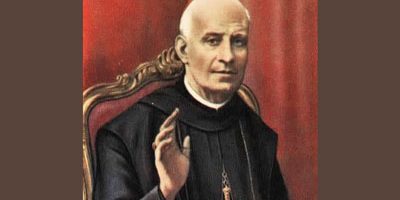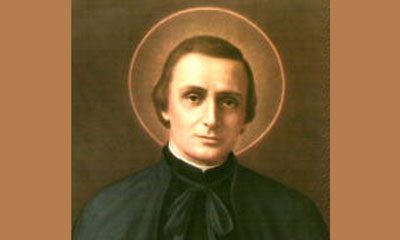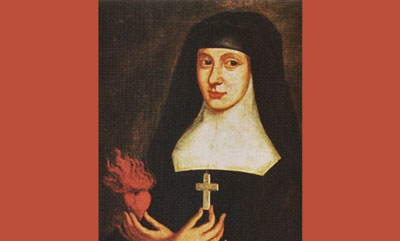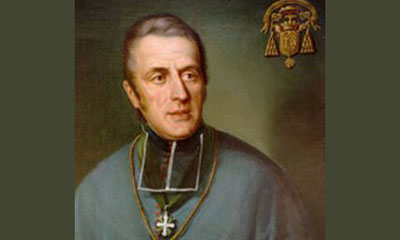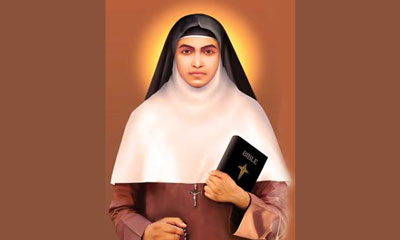August 29, 2017
Blessed Joseph Benedict Dusmet
Dear Friends,
For truly, I say to you, whoever gives you a cup of water to drink because you bear the name of Christ, will by no means lose his reward (Mk. 9:41). In his beatification homily for Cardinal Joseph Benedict Dusmet on September 25, 1988, Saint John Paul II said that the Cardinal certainly “meditated at great length on these words from the Gospel… He was a monument of evangelical charity in a particularly tormented time in the life of the Church, with violent conflicts and deep changes in Italy’s political and social fabric, in a region shaken by great natural disasters—cholera epidemics, earthquakes, floods, eruptions of Mount Etna, not to mention the great and constant disaster that is the poverty of the disadvantaged.”
 A Belgian Navy officer and captain of the ship, Louis Dusmet was shipwrecked off the coast of Sicily. He then settled on this island and married the Marquise Maria Dragonetti. On September 15, 1818, the young couple welcomed their first son. At his baptism, the child was placed under the protection of twelve saints, but the family called him Melchior. Six brothers and sisters would follow. From the age of five, Melchior showed an inclination toward acts of piety and charity toward the poor. His parents entrusted him to the Benedictine Fathers of the Abbey of San Martino delle Scale, not far from Palermo, in Sicily. These Fathers prepared him for First Communion and Confirmation.
A Belgian Navy officer and captain of the ship, Louis Dusmet was shipwrecked off the coast of Sicily. He then settled on this island and married the Marquise Maria Dragonetti. On September 15, 1818, the young couple welcomed their first son. At his baptism, the child was placed under the protection of twelve saints, but the family called him Melchior. Six brothers and sisters would follow. From the age of five, Melchior showed an inclination toward acts of piety and charity toward the poor. His parents entrusted him to the Benedictine Fathers of the Abbey of San Martino delle Scale, not far from Palermo, in Sicily. These Fathers prepared him for First Communion and Confirmation.
The seductions of the world
At the end of his first studies, the young man expressed his desire to become a monk. In response, his father sent him to Naples to discover the world, in order to test his vocation. Nothing was able to make his desire falter. So at the age of fifteen, he entered the Abbey of San Martino, taking the name Joseph Benedict. On August 15, 1840, he made his perpetual profession. Two years later, at the age of twenty-four, he was ordained to the priesthood. His Abbot tasked him with teaching philosophy and theology, as well as healing the internal dissension in the community, due in part to an excessive accumulation of temporal goods. Zealous in his observance of the Rule and endowed with a great capacity for work, Father Joseph Benedict found himself at odds with his confreres who had strayed from the old observances. Nevertheless, the Abbot, Dom Carlo Antonio, chose him for his personal secretary. In 1847, Dom Carlo was elected Abbot of Santa Flavia in Catanissetta, and Father Joseph followed him to this abbey. His qualities were soon noticed, and the bishop of the diocese chose him as an advisor, as much for spiritual as temporal affairs.
In 1850, at the age of thirty-two, Father Joseph Benedict was named coadjutor of the Abbey of Saints Severino and Sossio in Naples. A model of religious observance, a trusted advisor, and a prudent and generous administrator, he did not hesitate to distribute food himself to the many beggars who crowded the Abbey door. For about ten years, he was called on to settle problems in a number of communities. Sent to the monastery of Saint Nicholas in Catania, which had become very lax, he was present when the Abbot soon breathed his last, and succeeded him in 1858. At the time many considered the monastery to be “a place of delights, where life unfolds without worry for the present or the future, in joyous banquets, sumptuous ceremonies, gay conversations and pleasant picnics.” Dom Joseph Benedict inaugurated his abbacy without any external festivity, and strove, with firmness and charity, to reestablish the Rule in the monastery. First, by his own example, he got the Fathers to give up their personal servants. During the summer, which the community had become accustomed to spending in Nicolosi, some monks would go to the casino and play cards, sometimes late into the night. Without a word of reproach, the Abbot stood at the entrance of the establishment; his presence alone was enough for them to understand the irregularity of their behavior and give it up.
Dom Joseph Benedict put into practice Saint Benedict’s advice: “The Abbot should govern his disciples in a twofold way, showing them all that is good and holy by his deeds more than by his words. Thus the intelligent among his disciples are told the commandments of the Lord out loud, but the hard-hearted or simple-minded are shown the divine precepts by his actions. In this way he should teach his disciples to avoid all that is contrary to the law of God.” (Rule, Ch. 2).
The last to leave
In Catania, the influence of Jansenism was still being felt among the clerics and faithful. To remedy the situation, the Father Abbot introduced devotion to the Sacred Heart of Jesus, a devotion of redemptive love and trust, and promoted frequent reception of the sacraments. He did not hesitate, when the opportunity arose, to be a missionary on foot, making home visits. He kept a distance from the political upheavals that shook Italy in the 1860s, but founded the “Saint Peter’s Pence”, which collected funds to support the Pope, who was being progressively stripped of his States by a nascent Italy. In 1860, the “Kingdom of Italy” seized Sicily. Laws abolishing religious orders were enacted. When his monastery was confiscated, Father Dusmet was the last to leave. He took refuge in the home of a courageous canon, and refused to go to Turin to negotiate for the survival of his community. Some criticized him for this, but subsequent events showed that the opportunities offered by the government were nothing more than bait.
Due to the political troubles, the episcopal seat of Catania had remained vacant since 1861. At the beginning of 1867, the Pope appointed Dom Joseph Benedict archbishop of Catania. This choice caused general rejoicing in the diocese—only self-interested parties were discontent. He received episcopal ordination in Rome on March 10, 1867. Without delay, he sent the faithful of his diocese a pastoral letter explaining why he had accepted this high office: “For us, to recuse ourselves in so difficult a situation would made us guilty of pushing away from our mouth a bitter chalice, leaving to the common Father of the faithful (the Pope) the full weight of responsibility; our refusal would have been an act of cowardice.” He outlined the program for his episcopacy: reforming the clergy, growing the faith, fidelity to the Supreme Pontiff, humility, and prayer. He gave first place to the virtue of charity which was so dear to his heart: “As long as we have a scrap of bread, we will share it with the poor. Our door will always be open to all the poor and suffering. The hours posted on our door must not keep the poor from being received at all hours. We will try to help them but, even if material means are lacking, a word of comfort and consolation will always be given.”
The new archbishop was permeated with the teachings of the Rule of Saint Benedict on the duties of an Abbot: “Above all let him not, overlooking or undervaluing the salvation of the souls entrusted to him, be too solicitous for fleeting, earthly, and perishable things; but let him ever bear in mind that he has undertaken the government of souls, for which he shall have to give an account” (Rule, Ch. 2). Archbishop Dusmet also remembered what Saint Benedict wrote about the steward of the monastery: “Let him above all things have humility; and to him on whom he has nothing else to bestow, let him give at least a kind word, as it is written: A good word is above the best gift (Sir. 18:17)” (ibid. Ch. 31).
Two rooms
As archbishop, Dom Joseph Benedict Dusmet did his utmost to maintain his monastic way of life. He rose early, celebrated Mass, assisted, as his act of thanksgiving, his secretary’s Mass, had a cup of coffee, then went to the church of Saint Agatha next door. Only then began his heavy workday, not even interrupted by a bit of rest in the afternoon. His lunch consisted of a few pieces of fruit and a little water. His main meal, very frugal, was taken in the evening. During Lent, he ate no meat. At the bishop’s palace, he arranged two room—one furnished suitably for an archbishop, the other, much more modest, where the monk usually took his rest. A crucifix, a picture of the Blessed Virgin, and a large rosary, a souvenir from a pilgrimage to Lourdes, were the only decorations. Moreover, he spent part of the night in the chapel, praying and meditating. In the midst of matters of pastoral governance, he strove to maintain interior recollection. He considered himself a sinner and humbly commended himself to the prayers of the poor he assisted, so as to obtain from God forgiveness for his sins. In town he traveled on foot, never using a carriage. A single chamberlain accompanied him, and he wore, as an emblem of his high office, a small gold cross on his monastic habit. In the exercise of his authority, he did not use a commanding tone, not even towards the people who worked for him. His model was Saint Francis de Sales.
This great Doctor of the Church, the bishop of Geneva, recommends gentleness, relying on Jesus’ words: learn of Me, because I am meek, and humble of heart (Mt. 11:29). Humility, he pointed out, perfects us towards God, and meekness towards our neighbor: “If possible, fall out with no one, and on no pretext whatever suffer your heart to admit anger and passion.” But if anger enters into our heart, “we ought to call upon God for help … for He will command our passions to cease, and there will be a great calm. But I warn you that the prayer which is made against present and pressing danger, must always be performed calmly and quietly, and not violently … Again, when your mind is in a state of tranquility, and without any cause for anger, …[do] all your actions, little and great, in the mildest manner possible.” The Saint then recommends gentleness towards oneself: “[Let us never fret] against ourselves and our imperfections … for it is no wonder that infirmity should be infirm, or weakness weak… Detest, nevertheless, with all your power the offense God has received from you” (Introduction to the Devout Life, Part III, Ch. 8 and 9).
Do not wound him
From the beginning of his episcopacy, Archbishop Dusmet vigorously defended the rights of the Church. Public officials appointed to enforce anticlerical laws acted with the greatest prudence towards him “so as not to offend such a man,” they said, but even more so out of fear of public opinion, which was not favorable towards them. These circumstances allowed the prelate to recover, bit by bit, most of the churches confiscated by the government, as well as the seminary, and obtain the reopening of religious houses. Very early on, he made a point of visiting the entire diocese, even the most remote villages. He organized parish missions, and stressed the need to teach the catechism. To meet the various needs of his faithful, he established numerous associations and schools which he looked after very carefully, and founded a home for the elderly, bringing in the Little Sisters of the Poor to care for them. For the poor, he organized a home-based care initiative and set up a hospital.
Aware of the importance of the role of the laity in evangelization, the archbishop of Catania wanted the faithful to be able to explain the faith to nonbelievers. Therefore he founded two periodicals devoted to doctrinal formation, which were produced by laymen.
In doing so, he anticipated the views of Saint John Paul II, who would write: “lay people as well are personally called by the Lord, from Whom they receive a mission on behalf of the Church and the world. … The situation today points to an ever-increasing urgency for a doctrinal formation of the lay faithful, not simply for a better understanding, which is natural to faith’s dynamism, but also in enabling them to give a reason for their hope in view of the world and its grave and complex problems. Hence the absolute necessity for a systematic approach to catechesis, geared to age and the diverse situations of life… This is especially true for the lay faithful who have responsibilities in various fields of society and public life. Above all, it is indispensable that they have a more exact knowledge … of the Church’s social doctrine” (Exhortation Christifideles laici, December 30, 1988, nos. 2 and 60).
Archbishop Dusmet also made sure that the faithful were formed in their prayer life. He organized pilgrimages, and promoted pious practices during the month of Mary as well as devotion to the Sacred Heart. Every year, he wrote a pastoral letter on the Virgin Mary. Thus it was that in May 1893, he could say: “In spite of the great poverty of meritorious works that I will have when I cross over, I think I will be able to present at least my twenty-five Marian letters as my single passport to the Queen of mercy at the final hour.” Attentive to the intellectual formation of his priests, and solicitous over their moral life, he reorganized the diocesan seminary. In his first pastoral letter, he had written to them: “Strive, my brothers, to gain public regard by good conduct, by being completely content with your situation and not seeking another one elsewhere, without spreading yourselves everywhere, remaining strictly united among yourselves. The atmosphere of politics and cliques, the spirit of dissension, have no place in the clergy. To raise oneself above the events of this world, to drink from the pure springs of divine grace, to place oneself under the light of God, such is the role of the priest.” Indeed, in this time of political unrest, defections of clerics were not rare. The archbishop sometimes had to reprimand the obstinate, but, resolved to be “more good than just,” his punishments were short. To prevent failures, he promoted the sanctification of his clergy through spiritual exercises and monthly meetings.
How to govern
Saint Benedict’s advice helped the prelate govern: “The Abbot in his teaching should always follow the pattern given by the Apostle, when he says: Reprove, entreat, rebuke (II Tim. 4:2): mingling, as occasions may require, gentleness with severity; showing now the rigor of a master, now the loving affection of a father. Thus, he should rebuke more sternly the undisciplined and restless, while it is enough to exhort the obedient, mild, and patient to greater virtue. Those who are negligent and haughty, we charge him to reprove and correct… Even in his corrections, let him act with prudence, and not go too far, lest in seeking too eagerly to scrape off the rust, the vessel be broken. Let him keep his own frailty ever before his eyes, and remember that the bruised reed must not be broken (Is. 42:3)” (Rule, Ch. 2 and 64).
Cholera broke out in Catania in 1867. The archbishop could be seen entering homes and slums to visit the sick and the dying, and to bring aid to survivors. If, out of fear of infecting him with the disease, someone refused to open the door to him, he did not hesitate to enter through the window or balcony. When overly fearful patients refused their prescribed medications, he himself swallowed several drops in front of them to show them they were not harmful. To alleviate all these miseries, he sold the decorative vases from the episcopal palace and even went into debt. He went so far as to give up his precious pectoral cross, but the Catanians bought it back and gave it to him. Twenty years later, the same scourge struck the city once again, and the archbishop devoted himself with the same zeal of charity, which he also poured out during earthquakes, famines, and storms.
In 1885, at the request of Pope Leo XIII, Archbishop Dusmet was tasked with administering, in addition to his own diocese, that of Castiglione, with the mission of pacifying the ongoing conflict between the ecclesiastical and civil authorities. His tact, his firmness at once gentle and persistent, and his charity helped him to succeed in this delicate task. In 1886, the Holy Father entrusted him with a new and important mission—to restore the Benedictine Order in Italy, which had been seriously damaged by the antireligious laws, and to promote unity within the order in Italy. The Abbots of the surviving monasteries of the Benedictine Congregation of Montecassino gathered under his leadership, and adopted several crucial directives. In his closing speech, Archbishop Dusmet urged them above all to fraternal love. He then obtained the collaboration of Abbots from all over the world, to establish a confederation of all the Benedictine Congregations that had been formed over the course of history. And thus was formed the Benedictine Confederation, endowed with two unifying mechanisms—an Abbot Primate and an educational institution, both headquartered in Rome, at the Abbey of Saint Anselm, to be built at the end of the century.
“
I have faith!”
The city of Catania and the surrounding area are constantly threatened by Etna’s eruptions. In 1886, one of them endangered the city of Nicolosi. The pastor went to Nicolosi, celebrated Mass in a town square, and exhorted the inhabitants to entrust themselves to God by approaching the sacraments. However, an enormous lava flow which had already forced a number of people to evacuate their homes was advancing towards the city. Archbishop Dusmet then had brought from Catania the reliquary containing the veil that had been recovered from the tomb of Saint Agatha (virgin, martyred in 251) so as to repeat Blessed Peter Geremia’s gesture. In the fifteenth century, this Dominican had averted the same danger by this means. To those who pointed out to him the recklessness of this gesture, the archbishop firmly replied: “I have faith!” He went towards the volcano, followed by the clergy and the people, and traced the sign of the cross three times with the veil, in the direction of the lava. The molten flow stopped and remained as if blocked. Two weeks later, the eruption had stopped.
In 1889, Leo XIII made Archbishop Dusmet a cardinal. When he took possession of his titular church, the basilica of Santa Pudenziana, in Rome, he gave up the tradition of offering a sumptuous banquet, and gave the money the event would have cost to charitable organizations. When he returned to Catania, he remained what he had been, humble and poor. However, as his seventy-fifth birthday approached, his strength was diminishing, and he felt strongly the weight of his lengthy episcopate. He was heard saying: “Oh! What a joy to die, to go to heaven, to heaven!” The last church he visited was the one he had had built in honor of the apparition of Our Lady of La Salette. Soon, uremia and its consequences forced him to be confined to bed, never to return to his feet again. This condition lasted for several months. Finally, he received the last rites with devotion, then begged: “Do not leave me in purgatory! A bishop’s responsibility is great!” He died on April 4, 1894, after having repeated several times: “O Saint Joseph, come quickly! Give me to my Jesus! Saint Joseph, take me quickly, my bags are packed! May I die the death of the just, and may my end be like theirs!” In accordance with his final wishes, his funeral was as simple as possible, in the presence of a great gathering of people.
On September 25, 1988, Saint John Paul II declared: “Although raised in a rich and aristocratic family, Cardinal Dusmet made himself poor in order to serve and give himself to others, a systematic and unwavering choice of lifestyle that was so radical that at his death they were unable to find even a sheet in which to wrap him. He had stripped himself of everything in order to clothe the poor, whose humble servant he considered himself.” Let us ask him to obtain for us the grace to follow, to the best of our ability, the examples of charity and humility he left us!


